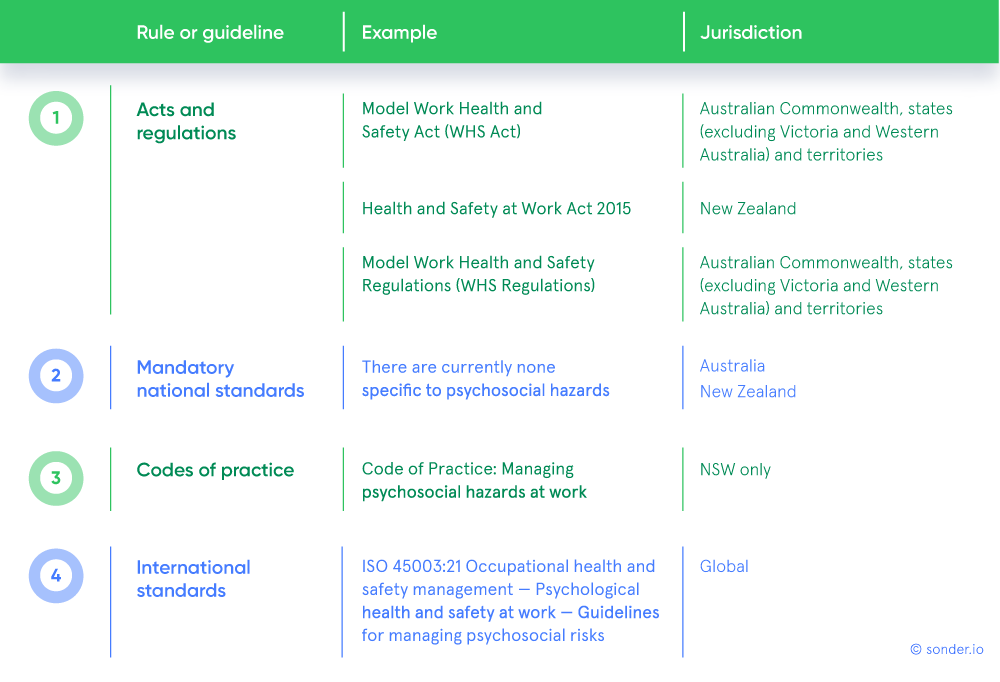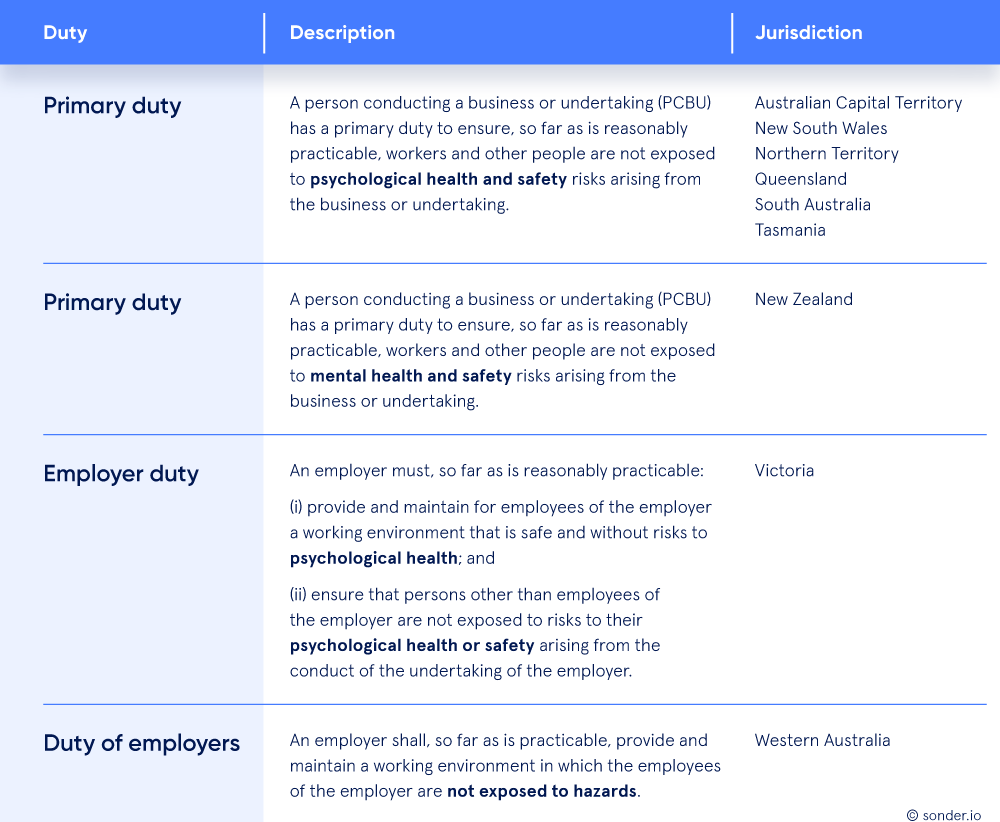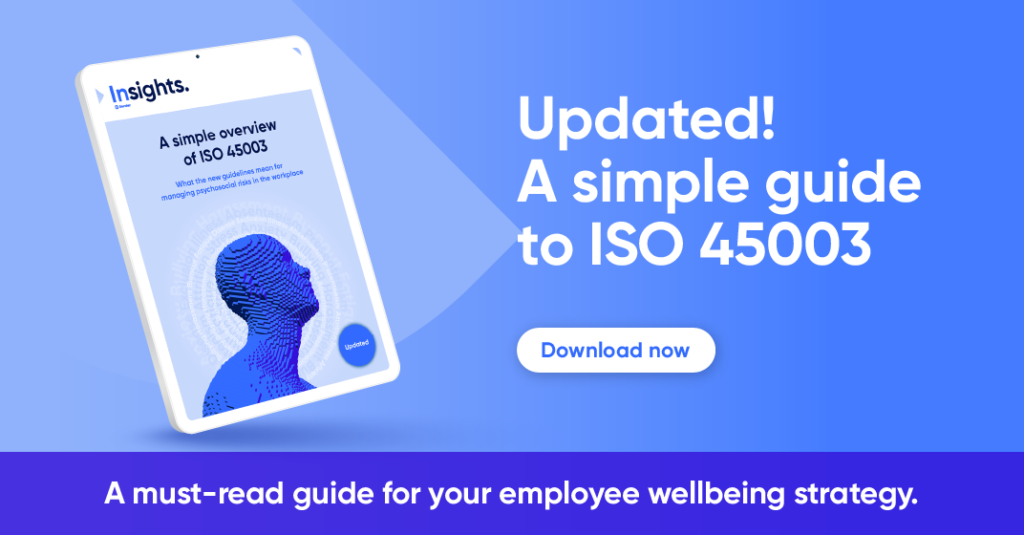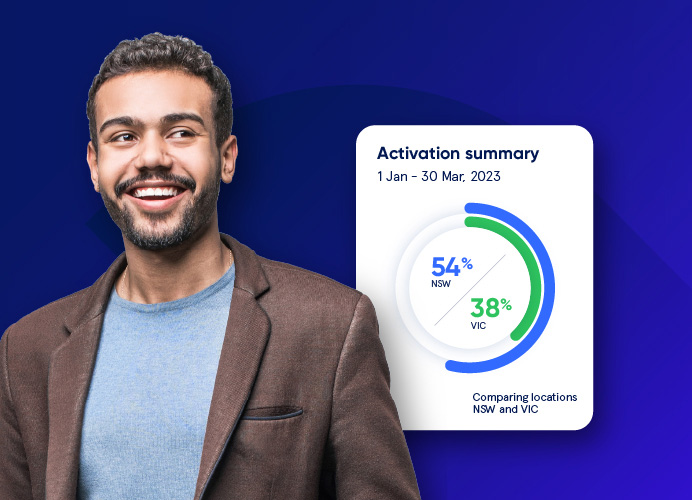How does ISO 45003 fit with existing WHS rules?

Insights.
One of the key questions asked by CEOs, board members, People and Culture Directors and WHS managers about ISO 45003 since its launch on 8 June 2021 is: “How does the new standard fit in with existing WHS rules and guidelines?”.
At a very basic level, the answer is that adherence to ISO 45003 is voluntary because it is a guidance standard not a requirements standard, with no official certification and no compliance check. However, dismissing ISO 45003’s best practice recommendations might arguably be considered negligent if a regulator were to determine that an organisation was aware of the best practice but chose to ignore it.
To understand how ISO 45003 fits into the broader WHS landscape in Australia and New Zealand, today’s post shares an excerpt from our recently released guide, A Simple Overview of ISO 45003: What the new guidelines mean for managing psychosocial risks in the workplace. For the complete picture we encourage you to download the full guide, which was prepared in conjunction with McCullough Robertson Lawyers, whose Employment Relations and Safety Group has extensive experience advising business and government on all aspects of WHS compliance, internal investigations, regulatory investigations and prosecutions.
Work Health and Safety (WHS) in Australia and New Zealand
There are four primary levels of regulations and guidelines across Australia and New Zealand:
Level 1: WHS Legislation
The strongest of these is the first level, which is enforceable by law, and comprises the WHS Act and WHS Regulations in Australia, and the Health and Safety at Work Act 2015 in New Zealand. The Australian rules came as a result of a 2009 National Review into Model Occupational Health and Safety Laws, which led the Commonwealth, Territories and States (except for Victoria and Western Australia) to adopt the Model Work Health and Safety Act (WHS Act) and the Model Work Health and Safety Regulations (WHS Regulations). The WHS Laws in each jurisdiction are therefore broadly the same (subject to minor variations). New Zealand’s Health and Safety at Work Act 2015 was based in part on Australia’s Model WHS Act (subject to some variations).
Level 2: Mandatory national standards
In a limited number of circumstances, WHS regulations mandate compliance with particular national standards, or at least parts of them. This means that failure to comply with that standard can amount to a breach of the applicable WHS law.
Level 3: Codes of practice
The WHS Act authorises the Ministers in each jurisdiction to approve a code of practice. Codes of practice should be followed and can be used by safety regulators in a prosecution as evidence of steps that could or should have been taken to comply with the law.
Level 4: International standards
International standards such as ISO 45003 – set by the International Organisation for Standardisation (ISO) – provide guidance for how to comply with duties under WHS laws, but they are not enforceable unless compliance is specifically mandated in WHS regulations. However, regulators looking for evidence of compliance with legislation may reflect on observance of recommendations in guidance documents, and organisations may choose to mandate compliance as part of a contractual requirement.

Jurisdictional duty
In May 2021, NSW implemented the Code of Practice: Managing psychosocial hazards at work. By doing so, they became the first AU/NZ jurisdiction to implement an approved code of practice addressing psychological health. That same month, Australia’s Ministers responsible for work health and safety discussed psychosocial hazards in the workplace, and a majority agreed to amend the model WHS Regulations to more specifically address psychological injury, however no further progress as yet.
For jurisdictions without a code of practice for managing psychosocial hazards in the workplace, ISO 45003 provides a useful guide to assist organisations to comply with their duties under WHS laws.
These duties vary slightly between the different jurisdictions, and each workplace will have a unique way of dealing with psychosocial hazards that is particular to the context and content of the work.

How can I comply with my duty?
ISO 45003 can help you comply with your jurisdictional duty in the following ways:
- Identify all psychosocial hazards and/or risks in the workplace;
- Assess and prioritise the psychosocial hazards and risks;
- Manage and minimise psychosocial hazards and risks;
- Review processes from identify to manage on a regular basis; and
- Respond to reports of psychosocial hazards and risks.
Want to learn more?
For more details and examples around complying with your duty, we encourage you to download our new guide here.
Our user-friendly guide also answers ISO 45003 FAQ such as:
- What is ISO 45003?;
- Why is ISO 45003 important?;
- What is psychosocial risk?;
- What is wellbeing at work?;
- Do organisations need to comply with ISO 45003?; and
- The ISO 45003 opportunity and next steps.
Disclaimer
This blog post and ISO 45003 guide cover legal and technical issues in a general way. (Parts of this post were prepared in conjunction with McCullough Robertson Lawyers.) It is not designed to express opinions on specific cases. The post is intended for information purposes only and should not be regarded as legal advice. Further advice should be obtained before taking action on any issue dealt with in this post.
About Sonder
Sonder is an Active Care technology company that helps organisations improve the wellbeing of their people so they perform at their best. Our mobile app provides immediate, 24/7 support from a team of safety, medical, and mental health professionals - plus onsite help for time-sensitive scenarios. Accredited by the Australian Council on Healthcare Standards (ACHS), our platform gives leaders the insights they need to act on tomorrow's wellbeing challenges today.
Related posts
There's so much more to share
Sonder is reimagining health, safety and wellbeing support. Sonder proves human centric care leads to earlier intervention. Sonder impacts one person at a time to drive meaningful change across an organisation. Sonder understands people and how to support them.







